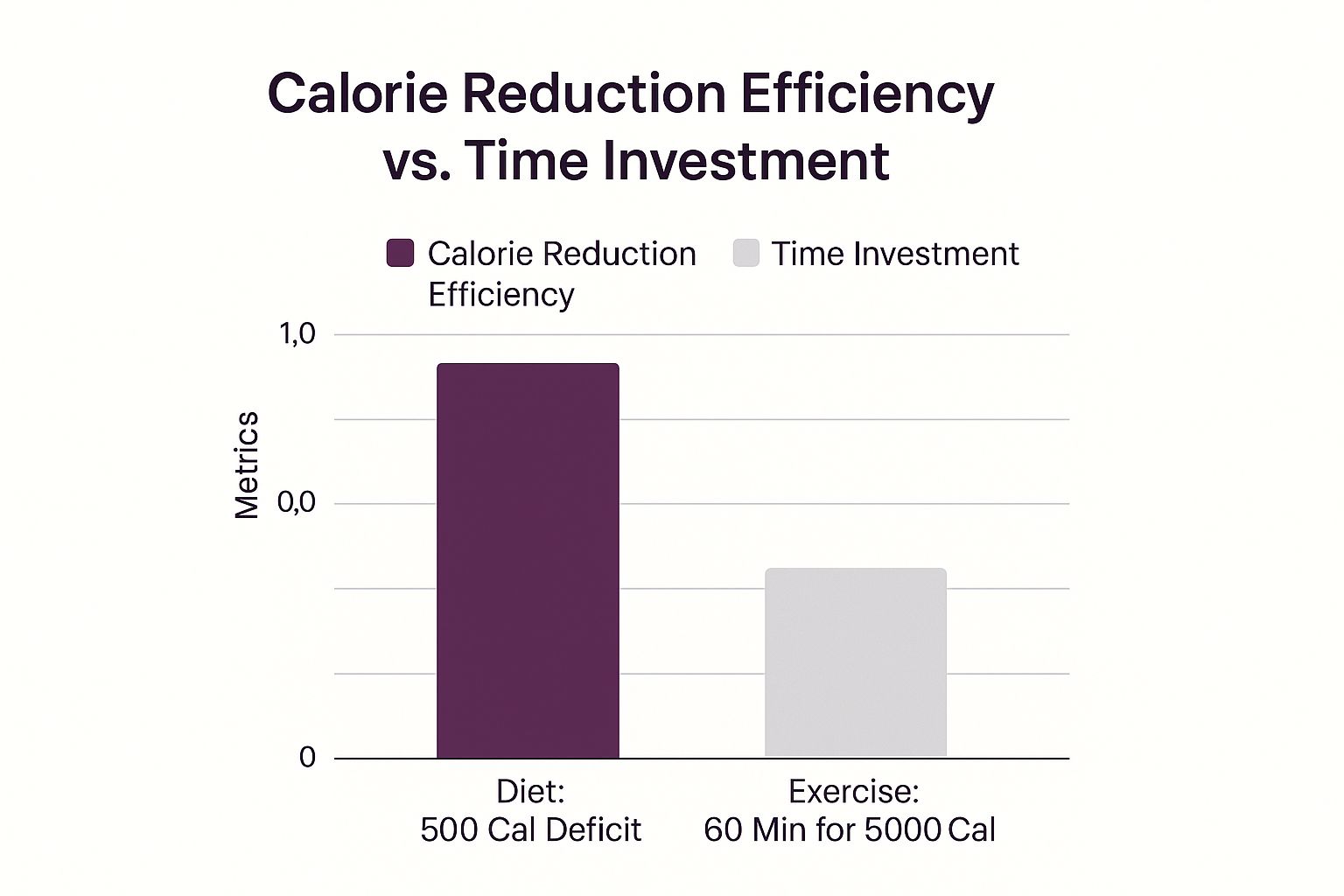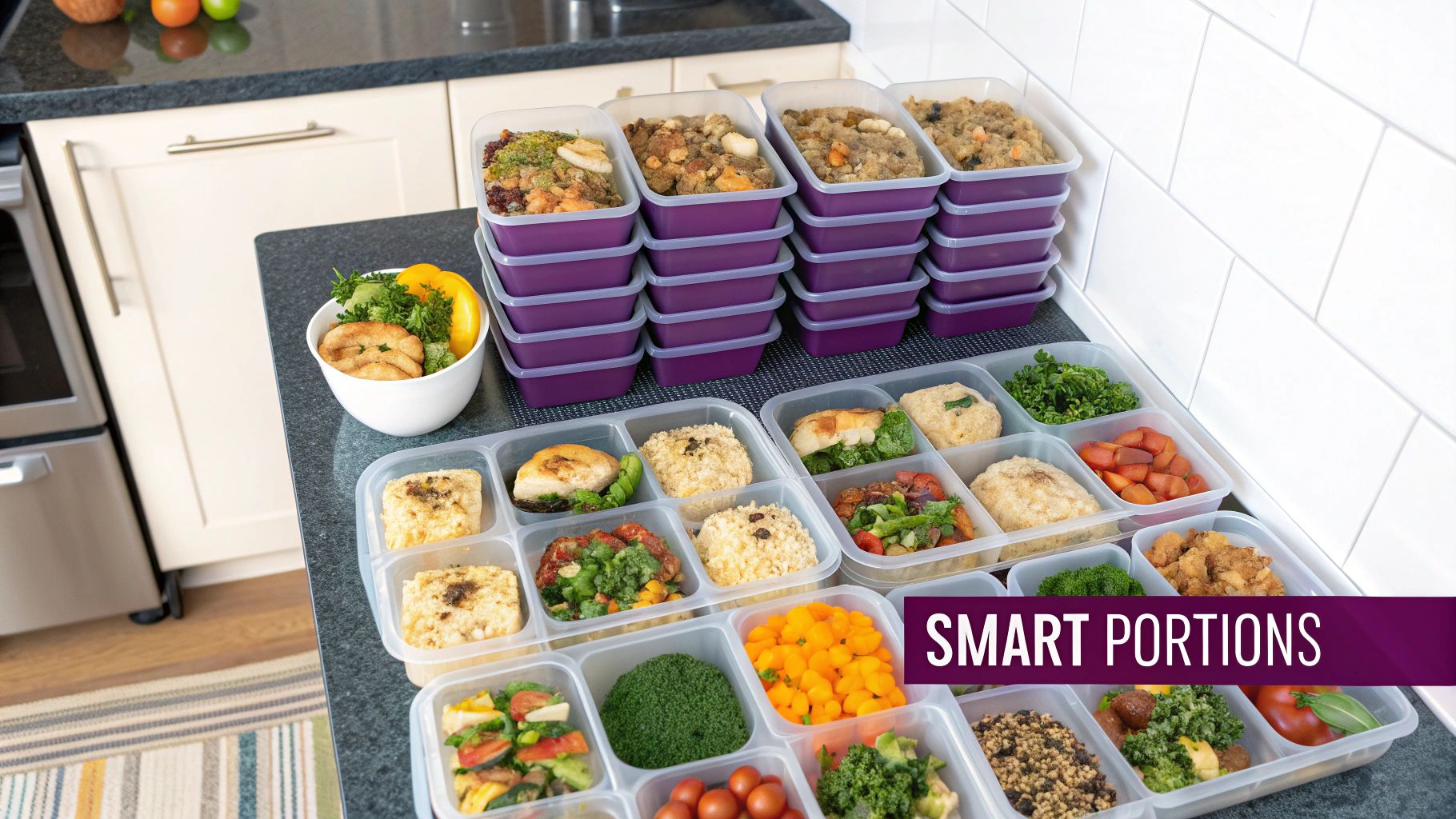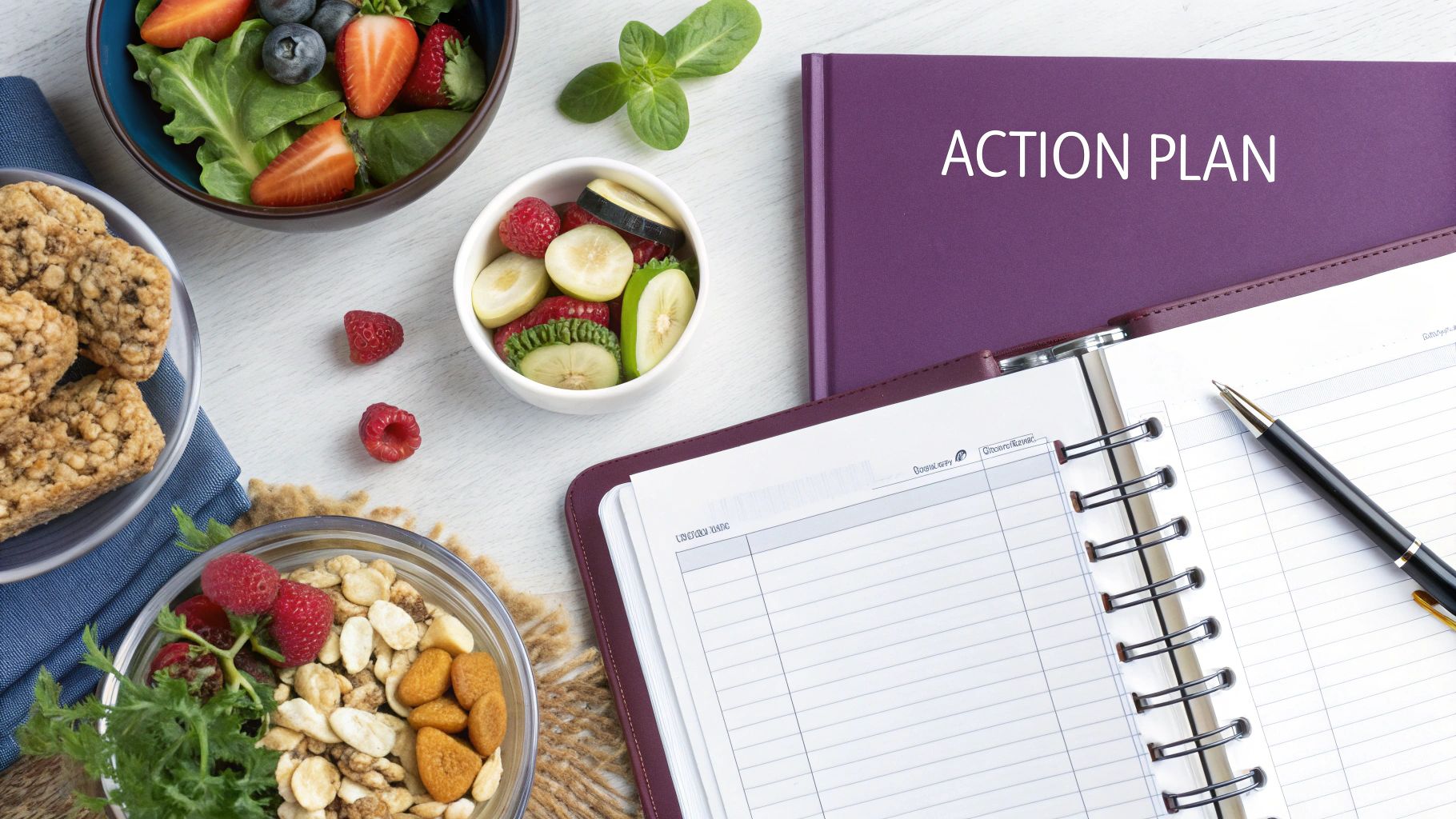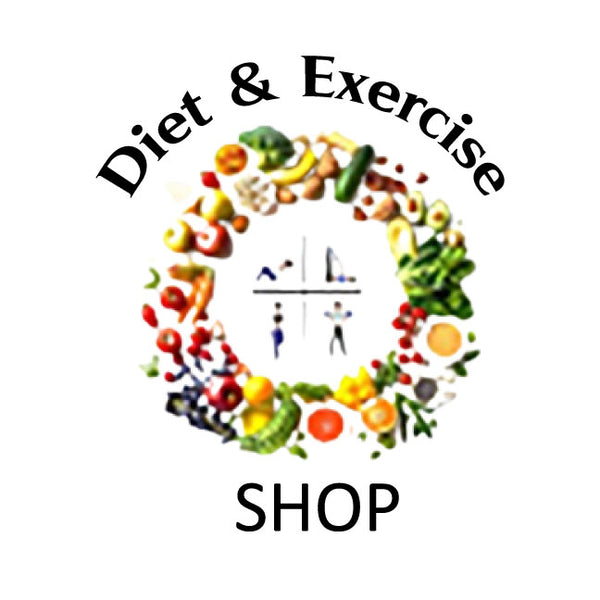
Diet Versus Exercise for Weight Loss: What Truly Works
When people ask about diet versus exercise for weight loss, the answer often surprises them. For the fastest initial results, diet is the clear winner. It's much easier to skip a 500-calorie snack than to burn that same amount on a treadmill.
But that's just the beginning. To keep the weight off long-term and build a stronger, healthier body, exercise is non-negotiable. The real secret isn't choosing one over the other; it's about combining them for powerful, lasting results.
The Core Principles of Weight Loss
Weight loss boils down to one simple rule: you need a calorie deficit. This means you must burn more calories than you consume. Both diet and exercise help you achieve this, but they work in different ways.
Think of it like managing your money. Dieting is like cutting your expenses—it's the fastest way to get your budget under control. Exercise is like getting a raise; it takes more effort but builds long-term security. One gives you immediate control, while the other builds a more resilient system for the future.
Comparing Core Impact on Weight Loss
To understand their roles, let's break down what each strategy brings to the table for weight loss.
| Factor | Diet (Calorie Control) | Exercise (Calorie Burn & Body Composition) |
|---|---|---|
| Speed of Results | High. Directly creates a calorie deficit for faster initial results. | Moderate. The calorie burn from a workout is often less than what you can easily cut from food. |
| Primary Mechanism | Reduces the number of calories coming into your body. | Increases the number of calories your body burns, both during activity and at rest. |
| Sustainability Role | Teaches healthy eating habits and creates the initial deficit. | Essential for maintaining weight loss, boosting metabolism, and improving overall health. |
| Body Composition | Can lead to both fat and muscle loss if protein isn't prioritized. | Preserves and builds lean muscle, which helps burn more calories around the clock. |
This table shows why diet has such an immediate impact. It’s a direct lever on your calorie balance. Exercise is a long-term investment in your body's metabolic engine.

As you can see, creating a 500-calorie deficit through diet can be a simple choice, while burning the same amount through exercise requires significant physical effort.
Why Diet Is More Effective Initially
When you look at the raw numbers, the "diet versus exercise" debate for getting started becomes clear. Controlling what you eat is a powerful tool for kicking off weight loss. Experts agree—and you can read more on the expert consensus on weight loss from the Mayo Clinic—that creating an energy deficit through food is far more efficient than trying to burn it all off through activity alone.
The most successful and sustainable weight loss plans do not treat diet and exercise as competitors. Instead, they leverage the strengths of both to create a powerful, synergistic effect that leads to lasting change.
How Diet Kicks Off Rapid Weight Loss
If you're looking for the fastest way to see the number on the scale go down, start with your plate. In the diet vs. exercise debate, nutrition almost always wins for initial results. It all comes down to the calorie deficit. You must consume fewer calories than your body burns, forcing it to use stored fat as fuel.
Think about it: a tough, hour-long gym session might burn 400-500 calories. You can create that exact same deficit by skipping a high-calorie coffee drink and a pastry. This is why diet is so powerful—it gives you direct, immediate control over your body's energy balance.

This isn't about one specific diet. Whether you go low-carb, track macros, or practice portion control, they all work on the same principle: creating a consistent calorie deficit. To learn more, check out our guide on what is a calorie deficit.
Making Smart Eating Your Default Setting
One of the biggest hurdles to eating well is the daily grind of planning and cooking. When you're busy or tired, grabbing something quick and easy is tempting. This is where a little planning changes everything.
Meal prepping is the solution. By setting aside a few hours one day a week to cook, you eliminate daily guesswork and decision fatigue. Your fridge will be stocked with healthy, portion-controlled meals ready to go.
To make this process effortless, the right gear helps. Our Smart Meal Prep Containers were designed for exactly this. The built-in compartments make portion control automatic, so you can manage your intake without constant measuring. They're durable, reusable, and perfect for organizing a week's worth of meals.
Investing in tools that simplify good habits sets you up for long-term success. You're not just "on a diet"; you're building a system where eating well becomes your new normal. Watch how easy it is to prep a full week of delicious, healthy food in this video from our Diet & Exercise YouTube channel.
Why Exercise Is Your Long-Term Success Engine
If a smart diet is the fastest way to see the scale drop, exercise is the engine that keeps you moving forward for good. It's a mistake to see a workout only as a way to burn off a treat. In the diet vs. exercise debate, physical activity plays a deeper role in reshaping your body.
You can't out-train a bad diet. But skipping exercise means you miss out on crucial metabolic advantages that are key to keeping weight off permanently. Moving your body does more than just burn calories; it rewires how your body uses energy.

Building Your Metabolic Furnace with Resistance Training
Resistance training—like using weights, bodyweight exercises, or resistance bands—is where the long-term magic happens. Its main benefit isn't the immediate calorie burn. Instead, it’s about how it changes your what is body composition over time.
When you do strength training, you build lean muscle. This muscle tissue is metabolically active, meaning it burns more calories at rest than fat does. Every pound of muscle you add acts like a tiny furnace, constantly using energy, even when you’re asleep.
This metabolic boost is critical because it fights weight loss plateaus, ensures you lose fat instead of muscle, and shapes your body for a toned, firm physique.
The Perfect Tool for Building Strength Anywhere
You don't need a pricey gym membership to start building that metabolic furnace. An Adjustable Resistance Band Set is the perfect way to build strength from the comfort of your home.
These bands offer variable resistance, making them versatile for everyone from beginners to experts. They let you perform a huge range of exercises targeting every major muscle group, helping you build that stronger, more metabolically active body.
Ready to see for yourself? Follow along with our guided full-body resistance band workout on the Diet & Exercise YouTube channel. This routine will help you build strength and kickstart your journey to long-term success.
Unlocking Synergy: Combining Diet and Exercise
The real magic in weight loss isn't about choosing a side in the diet vs. exercise debate. The most powerful results happen when you treat them as partners. When a smart diet and consistent exercise work together, they create a synergistic effect greater than either could achieve alone.
Think of it this way: your diet creates the calorie deficit that signals your body to burn fat. At the same time, exercise reshapes your body, protects your metabolism, and ensures the weight you're shedding is mostly fat—not precious, calorie-burning muscle.
Protecting Your Metabolic Engine
A common problem with dieting alone is that your body can break down muscle tissue for energy. This is a huge setback because muscle is metabolically active. The more you have, the more calories you burn all day long.
Losing muscle slows your metabolism, which is why many people who only diet hit a plateau and regain the weight. Exercise, especially strength training, signals your body to hold onto muscle while you're in a calorie deficit. This is how you get leaner and stronger, not just smaller. You can read more about these powerful findings on diet and exercise synergy on Healthline.
The Power of Data-Driven Progress
How do you know if your strategy is working? The number on a regular bathroom scale only tells part of the story. It can't distinguish between a pound of fat and a pound of muscle, which can be misleading.
Understanding your body composition is a game-changer. You want to see your body fat percentage go down while your muscle mass stays the same or increases. That's the real sign of progress.
For this, you need a tool that sees beyond a single number. The Digital Smart Scale with Body Composition Analysis is designed to give you this insight. It tracks the metrics that matter: Body Fat Percentage, Muscle Mass, Body Water, and BMI.
Having this detailed feedback shifts your focus from simply "losing weight" to the much more important goal of "losing fat and getting stronger." Seeing your muscle mass hold steady as your fat percentage drops proves you're on the right track. Stop guessing and start measuring what truly matters with a tool like the Digital Smart Scale with Body Composition Analysis from our shop.
Actionable Plans for Your Fitness Goals
Knowing the theory is one thing, but turning it into results takes a concrete plan. Different goals require different approaches. Let’s break down actionable strategies for common scenarios, combining specific diet and exercise habits.

Think of these as starting points. Your personal journey will always need tweaking, but these frameworks provide the structure to start strong.
Goal 1: Losing the First 15 Pounds
This initial phase is about building momentum and habits. Your diet will do the heavy lifting to create a calorie deficit, with exercise supporting your metabolism.
Diet & Exercise Plan:
- Diet: Aim for a 500-750 calorie deficit daily. Prioritize protein in every meal and fill up on fiber from veggies and whole grains. Use our Smart Meal Prep Containers to make portion control simple and consistent.
- Exercise: Aim for 3-4 sessions per week. Include 2-3 full-body strength workouts using an Adjustable Resistance Band Set and 30-45 minutes of moderate cardio like brisk walking on other days. For a great starting routine, try this full-body resistance band workout on our YouTube channel.
Goal 2: Breaking Through a Weight Loss Plateau
It happens to everyone—the scale stops moving. Your body has adapted, so it's time to shake things up.
Diet & Exercise Plan:
- Diet: Recalculate your calorie needs for your new weight and adjust your deficit. Try carb cycling—more carbs on strength training days, fewer on rest days—to give your metabolism a jolt.
- Exercise: Increase to 4-5 sessions per week and focus on intensity. Swap some cardio for High-Intensity Interval Training (HIIT) and increase the resistance in your strength workouts.
- Track Smart: This is when a tool like the Digital Smart Scale with Body Composition Analysis becomes essential. It will show you if you're building muscle while losing fat, which means you're still making progress even if your total weight is stable.
Goal 3: Building Lean Muscle Tone
Here, the focus shifts from pure weight loss to body recomposition—shedding fat while carving out muscle definition.
Diet & Exercise Plan:
- Diet: Eat at a slight calorie deficit (200-300 calories) or at maintenance. A high protein intake (0.7–1.0 grams per pound of body weight) is non-negotiable to provide the building blocks for muscle.
- Exercise: Resistance training is now the star. Aim for 4-5 strength sessions per week, focusing on compound lifts like squats, push-ups, and rows. Use heavier resistance to challenge your muscles.
- The Right Tools: The Advanced Toning Bundle, with its heavier resistance bands and smart scale, is perfectly designed for this phase. It gives you the tools to push your body to the next level while accurately tracking your muscle gains.
Answering Your Top Weight Loss Questions
As you start your plan, you'll have questions. Getting clear answers is what keeps you moving forward with confidence.

Can I Lose Weight with Diet Alone?
Yes, absolutely. Weight loss hinges on a calorie deficit, and it's easier to create that by eating less.
However, relying only on diet can lead to muscle loss, which slows your metabolism and can result in a "skinny fat" look. A combined approach is always better for lasting, toned results.
How Much Exercise Do I Really Need?
A great goal is 150-300 minutes of moderate-intensity cardio a week (like brisk walking or cycling) plus at least two strength training sessions.
The best workout is one you'll do consistently. Find activities you enjoy. For an easy-to-follow routine, check out this Full Body Resistance Band Workout from our Diet & Exercise channel.
What Is Better for Losing Belly Fat?
You can't "spot-reduce" fat from your belly. To lose belly fat, you must reduce your overall body fat, and that mission starts in the kitchen with a consistent calorie deficit.
Exercise is a critical partner. High-intensity interval training (HIIT) is especially good at targeting visceral fat. Core exercises build abdominal muscles, creating a leaner midsection as the fat comes off. The winning formula is always a smart diet plus a consistent workout routine.
Here at Diet & Exercise, we know that having the right gear can make all the difference. From meal prep containers that simplify healthy eating to resistance bands for a great workout anywhere, we have the tools to support you.
Discover the tools for your success at https://dietexerciseshop.com.
